ISSN ONLINE(2320-9801) PRINT (2320-9798)
ISSN ONLINE(2320-9801) PRINT (2320-9798)
Shiwam S. Thakare1, Amit M. Sahu2
|
| Related article at Pubmed, Scholar Google |
Visit for more related articles at International Journal of Innovative Research in Computer and Communication Engineering
Image de-noising is a process of improving the quality of image by improving its feature. Image denoising is often used in the field of photography or publishing where an image is somehow degraded but needs to be improved before it is utilized. In this paper, various de-noising techniques for underwater images are presented. The underwater images have different degrees of distortions when compared to images from a clearer environment, so it is necessary to deal with such images. Under the influence of underwater special environment, lot of noise occurs due to low contrast, poor visibility conditions, absorption of natural light, non uniform lighting, color variations and blur effect, hence an object identification become typical task. Because of all these reasons, different filtering & Correction techniques are used for processing and enhancement of such underwater images.
KEYWORDS |
| PSNR, MSE, Underwater, Denoising, wavelet transform, adaptive threshold, etc |
I. INTRODUCTION |
| In order to deal with underwater image processing, first consider all the basic physics of the light propagation in the water medium. Physical properties of the medium cause degradation effects not present in normal images taken in air. Underwater images are essentially characterized by their poor visibility because light is exponentially attenuated as it travels in the water and the scenes result poorly contrasted and hazy. Light attenuation limits the visibility distance at about twenty meters in clear water and five meters or less in turbid water. The light attenuation process is caused by absorption (which removes light energy) and scattering (which changes the direction of light path). |
| The absorption and scattering processes of the light in water influence the overall performance of underwater imaging systems. Forward scattering (randomly deviated light on its way from an object to the camera) generally leads to blurring of the image features. On the other hand, backward scattering (the fraction of the light reflected by the water towards the camera before it actually reaches the objects in the scene) generally limits the contrast of the images, generating a characteristic veil that superimposes itself on the image and hides the scene. Absorption and scattering effects are due not only to the water itself but also to other components such as dissolved organic matter or small observable floating particles. The presence of the floating particles known as "marine snow" (highly variable in kind and concentration) increase absorption and scattering effects. |
| The visibility range can be increased with artificial lighting but these sources not only suffer from the difficulties described before (scattering and absorption), but in addition tend to illuminate the scene in a non uniform fashion, producing a bright spot in the centre of the image with a poorly illuminated area surrounding it. Finally, as the amount of light is reduced when we go deeper, colours drop off one by one depending on their wavelengths. The blue colour travels the longest in the water due to its shortest wavelength, making the underwater images to be dominated essentially by blue colour. The images is of interested can suffer from one or more of the following problems: limited range visibility, low contrast, non uniform lighting, and blurring, bright artifacts, colour diminished (bluish appearance) and noise. |
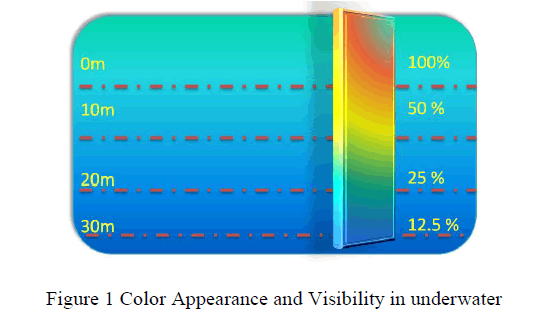 |
| Therefore, application of standard computer vision techniques to underwater imaging requires dealing first with these added problems. The image processing can be addressed from two different points of view: as an image restoration technique or as an image enhancement method: The image restoration aims to recover a degraded image using a model of the degradation and of the original image formation; it is essentially an inverse problem. These methods are rigorous but they require many model parameters (like attenuation and diffusion coefficients that characterize the water turbidity) which are only scarcely known in tables and can be extremely variable. Another important parameter required is the depth estimation of a given object in the scene. Image enhancement uses qualitative subjective criteria to produce a more visually pleasing image and they do not rely on any physical model for the image formation. |
II. RELATED WORK |
| This section presents related literature concerning underwater image processing techniques. |
| For the problem of underwater image de-noising, a new method based on adaptive wavelet combining adaptive threshold selection with adaptive output of the threshold function is proposed. Considering the underwater image with low SNR, contrast imbalance, and poor image quality, first some pre-processing should be done before wavelet threshold de-nosing. Then, adopted adaptive wavelet combining adaptive threshold selection with adaptive output of the threshold function for the image de-noising. Finally the simulation results show that the proposed method not only removes noise effectively, improves image output peak signal-to-noise ratio (PSNR), but also yields superior vision quality and embodies the superiority of wavelet de-noising [1]. |
| A new vectorial underwater image quality metric, dubbed the CQ that integrates the power spectrum. Unlike existing objective underwater image quality metrics, the proposed metric consists of a discriminator C based on the slope of the log-contrast power spectrum that is able to distinguish between marine habitats when a large number of images of different environments are to be processed, and a patch-based metric Q to predict the objective quality of underwater images. Experimental results illustrate that the proposed CQ metric is able to recognize underwater images with similar sharpness and correlates better with enhancement results compared to other methods, and also meet realtime requirements [2]. |
| Light scattering is caused by light incident on objects reflected and deflected multiple times by particles present in the water before reaching the camera. This in turn lowers the visibility and contrast of the image captured. Color change corresponds to the varying degrees of attenuation encountered by light traveling in the water with different wavelengths, rendering ambient underwater environments dominated by a bluish tone. No existing underwater processing techniques can handle light scattering and color change distortions suffered by underwater images, and the possible presence of artificial lighting simultaneously, a novel systematic approach to enhance underwater images by a dehazing algorithm, to compensate the attenuation discrepancy along the propagation path, and to take the influence of the possible presence of an artifical light source into consideration [3]. |
| Within the last decades, improving the quality of an underwater image has received considerable attention due to poor visibility of the image which is caused by physical properties of the water medium. This paper presents a new method called mixture Contrast Limited Adaptive Histogram Equalization (CLAHE) color models that specifically developed for underwater image enhancement. The method operates CLAHE on RGB and HSV color models and both results are combined together using Euclidean norm. Experimental results show that the proposed approach significantly improves the visual quality of underwater images by enhancing contrast, as well as reducing noise and artifacts [5]. |
III. PROBLEM STATEMENT |
| In the existing System, the processing is done on the underwater images, which is able to enhance the color and brightness of the image, but they are not efficient to remove noise correctly. Many important features get diminished from the image, which makes object identification a difficult task. |
| The Objective is to improve underwater image by using de-noising techniques, the processing of underwater image is necessary because the quality these image leads some serious problems when compared to images from a clearer environment. Numbers of methods are there to cure these underwater images by using different filtering techniques which are also available in the literature for processing and enhancement of underwater images, |
| The proposed system is an initiative to solve the above problem. The system is motivated from the literature survey of the wavelet transformation technique. In this system preprocessing is done on the underwater image using filtering technique, which makes the image look more prominent .After preprocessing adaptive wavelet transformation is applied. So that more accurate denoised outputs is achieved. The system is able to solve all or some of the objectives that are defined below: |
| • Remove noise, |
| • Improve the PSNR, |
| • Reduction of time and manual efforts, |
| • Better the visual effect by improving dark regions, global contrast significantly. |
IV. PROPOSED WORK |
| In order to achieve better de-noising effect, some pre-processing should be done before wavelet threshold de-nosing. The pre-processing contains two steps, the first step is to use Homomorphic filtering technology to eliminate the nonuniform illumination and balance contrast. This step can realize the purpose to reduce the illumination changes, sharpen the edge details, preserve details and eliminate the noise in the image. The filter function H(u,v) can be chose as follows. |
 |
| Where rH and rL are the maximum and minimum coefficient values and δω is a factor which controls the cut-off frequency. The second step is to apply Gaussian low-pass filtering for smoothing image. It is used to smooth textures and reduce artifact by deleting small image features amplified by Homomorphic filtering. Low-pass filtering is the essence of the image smoothing, which let the low frequency parts of signal access and tackle the high frequency parts of signal. Due to the image edge in high frequency parts, so it often results a certain destruction to detail in the image smoothly operation. The method of Gaussian low-pass filtering can avoid the defects. Using the representation of a Gaussian low-pass filtering is as follows |
 |
| Here D(u,v) is the distance of after Fourier transform form the origin. |
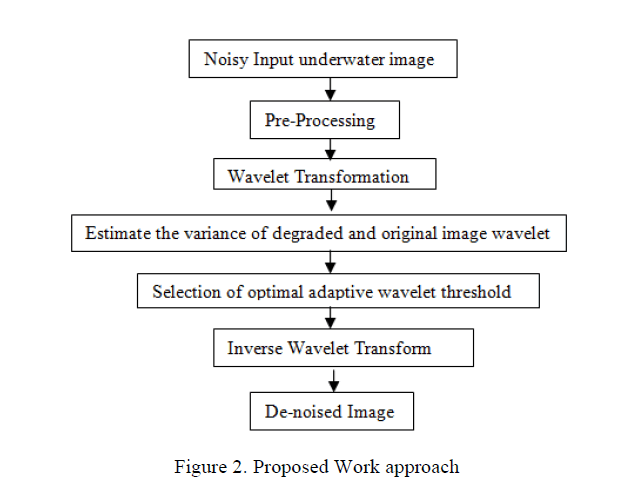 |
A) Classifying image data |
| An image is represented as a two-dimensional array of coefficients, each coefficient representing the brightness level in that point. When looking from a higher perspective, no one can't differentiate between coefficients as more important ones, and lesser important ones. |
| Most natural images have smooth color variations, with the fine details being represented as sharp edges in between the smooth variations. Technically, the smooth variations in color can be termed as low frequency variations and the sharp variations as high frequency variations. |
| The low frequency components (smooth variations) constitute the base of an image, and the high frequency components (the edges which give the detail) add upon them to refine the image, thereby giving a detailed image. Hence, the smooth variations are demanding more importance than the details. |
| Separating the smooth variations and details of the image can be done in many ways. One such way is the decomposition of the image using a Discrete Wavelet Transform (DWT). |
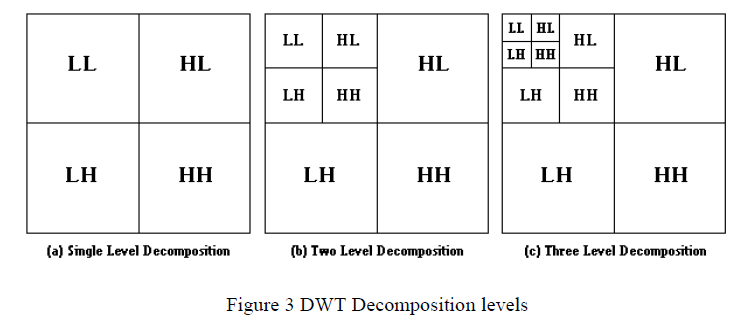 |
B) The Inverse DWT of an image |
| Just as a forward transform to used to separate the image data into various classes of importance, a reverse transform is used to reassemble the various classes of data into a reconstructed image. A pair of high pass and low pass filters is used here also. This filter pair is called the Synthesis Filter pair. The filtering procedure is just the opposite - it starts from the topmost level, apply the filters column wise first and then row wise, and proceed to the next level, till it reach the first level. |
C) Adaptive wavelet thresholding |
| During the wavelet de-nosing, the most important steps are the choices of an appropriate threshold and effective threshold function, which have direct impacts on the performance of a wavelet de-nosing algorithm. The key of the wavelet threshold de-noising is the relation between wavelet coefficient and threshold. The choice of the threshold determines the coefficient of the wavelet reconstruction. So the selection of adaptive wavelet threshold will help to achieve better de-noising effect. |
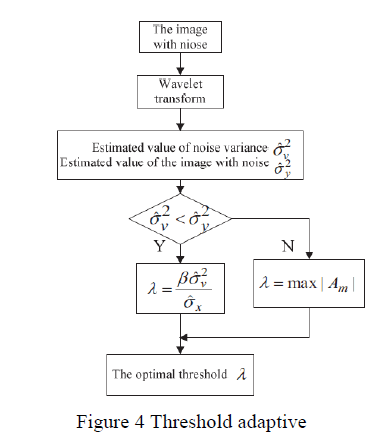 |
| D) De-noising algorithms that use the wavelet transformation consist of three steps: |
| i. Calculate the wavelet transform of the noisy signal, |
| ii. Modify the noisy wavelet coefficient according to adaptive thresholding, |
| iii. Compute the inverse transform using the modified coefficients. |
| E) Wavelet Domain Advantages: |
| Why we prefer De-noising in wavelet domain, because it has many advantage, like: |
| i. Wavelet based de-noising provides multi resolution hierarchical characteristics. Hence an image can be de-noised at different levels of resolution and can be sequentially processed from low resolution to high resolution. |
| ii. High robustness as compared to common signal processing. |
V. SIMULATION RESULTS |
| In order to verify the validity of the algorithm, simulation experiments are shown on jellyfish image, MATLAB is used as the simulation experiments tool. In the first step, the Homomorphic filtering is used to correct non-uniform illumination and to enhance the contrast in the image. In the second step, Gaussian low-pass filtering is used to smooth the image in homogeneous area, reserves image features and enhance image details. |
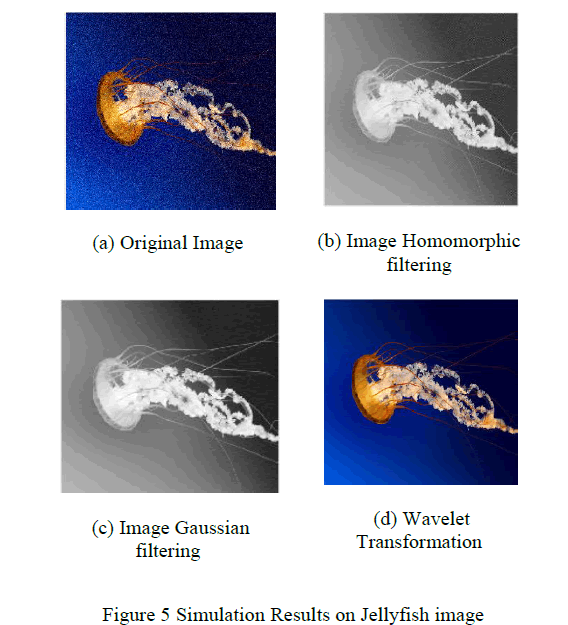 |
 |
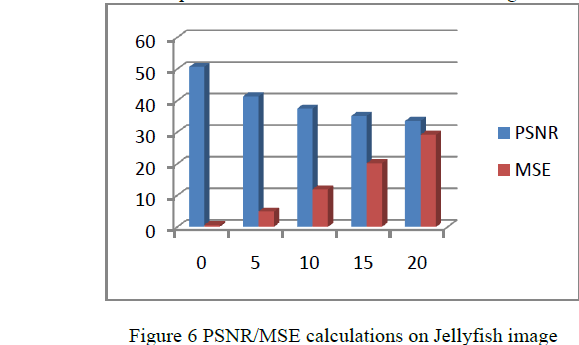 |
| The above figure presents the bar graph of PSNR/MSE values which are calculated on Jellyfish image |
VI. APPLICATIONS |
| • To analyse and investigate the images features and properties. |
| • To enhance and preserve underwater images for studying underwater life. |
| • To remove the noise and make object identification easy task, for archaeological surveys. |
| • To make image look more prominent for doing research work. |
VII. CONCLUSION |
| The difficulty associated with obtaining visibility of objects at long or short distance in underwater scenes presents a challenge to the image processing community. Even if numerous approaches for image processing are available, they are mainly limited to ordinary images and few approaches have been specifically developed for underwater images. Thus the proposed system has made fusion of the available methods for image restoration and image enhancement. The proposed algorithm produces prominent images which not only remove noise, improve the PSNR, but also get a better visual effect. |
References |
|